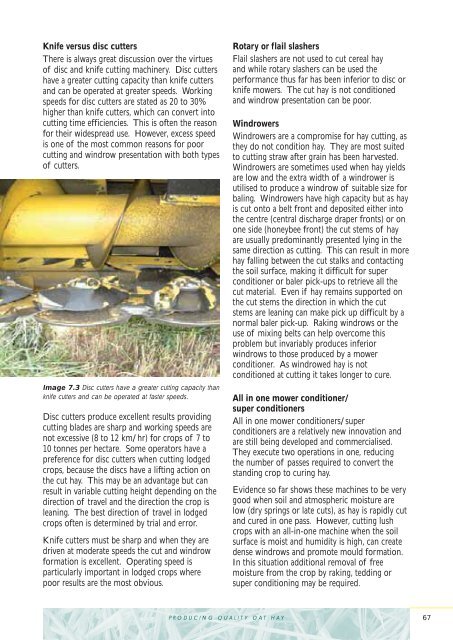Create successful ePaper yourself
Turn your PDF publications into a flip-book with our unique Google optimized e-Paper software.
Knife versus disc cutters<br />
There is always great discussion over the virtues<br />
of disc and knife cutting machinery. Disc cutters<br />
have a greater cutting capacity than knife cutters<br />
and can be operated at greater speeds. Working<br />
speeds for disc cutters are stated as 20 to 30%<br />
higher than knife cutters, which can convert into<br />
cutting time efficiencies. This is often the reason<br />
for their widespread use. However, excess speed<br />
is one of the most common reasons for poor<br />
cutting and windrow presentation with both types<br />
of cutters.<br />
Image 7.3 Disc cutters have a greater cutting capacity than<br />
knife cutters and can be operated at faster speeds.<br />
Disc cutters produce excellent results providing<br />
cutting blades are sharp and working speeds are<br />
not excessive (8 to 12 km/hr) for crops of 7 to<br />
10 tonnes per hectare. Some operators have a<br />
preference for disc cutters when cutting lodged<br />
crops, because the discs have a lifting action on<br />
the cut hay. This may be an advantage but can<br />
result in variable cutting height depending on the<br />
direction of travel and the direction the crop is<br />
leaning. The best direction of travel in lodged<br />
crops often is determined by trial and error.<br />
Knife cutters must be sharp and when they are<br />
driven at moderate speeds the cut and windrow<br />
formation is excellent. Operating speed is<br />
particularly important in lodged crops where<br />
poor results are the most obvious.<br />
PRODUCING QUALITY OAT HAY<br />
Rotary or flail slashers<br />
Flail slashers are not used to cut cereal hay<br />
and while rotary slashers can be used the<br />
performance thus far has been inferior to disc or<br />
knife mowers. The cut hay is not conditioned<br />
and windrow presentation can be poor.<br />
Windrowers<br />
Windrowers are a compromise for hay cutting, as<br />
they do not condition hay. They are most suited<br />
to cutting straw after grain has been harvested.<br />
Windrowers are sometimes used when hay yields<br />
are low and the extra width of a windrower is<br />
utilised to produce a windrow of suitable size for<br />
baling. Windrowers have high capacity but as hay<br />
is cut onto a belt front and deposited either into<br />
the centre (central discharge draper fronts) or on<br />
one side (honeybee front) the cut stems of hay<br />
are usually predominantly presented lying in the<br />
same direction as cutting. This can result in more<br />
hay falling between the cut stalks and contacting<br />
the soil surface, making it difficult for super<br />
conditioner or baler pick-ups to retrieve all the<br />
cut material. Even if hay remains supported on<br />
the cut stems the direction in which the cut<br />
stems are leaning can make pick up difficult by a<br />
normal baler pick-up. Raking windrows or the<br />
use of mixing belts can help overcome this<br />
problem but invariably produces inferior<br />
windrows to those produced by a mower<br />
conditioner. As windrowed hay is not<br />
conditioned at cutting it takes longer to cure.<br />
All in one mower conditioner/<br />
super conditioners<br />
All in one mower conditioners/super<br />
conditioners are a relatively new innovation and<br />
are still being developed and commercialised.<br />
They execute two operations in one, reducing<br />
the number of passes required to convert the<br />
standing crop to curing hay.<br />
Evidence so far shows these machines to be very<br />
good when soil and atmospheric moisture are<br />
low (dry springs or late cuts), as hay is rapidly cut<br />
and cured in one pass. However, cutting lush<br />
crops with an all-in-one machine when the soil<br />
surface is moist and humidity is high, can create<br />
dense windrows and promote mould formation.<br />
In this situation additional removal of free<br />
moisture from the crop by raking, tedding or<br />
super conditioning may be required.<br />
67

















